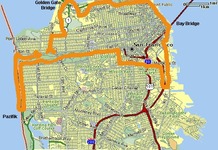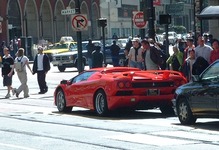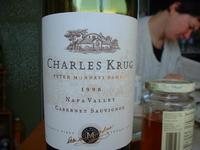 |
| Angelika/Mike Schilli |
|
Michael On July 8th, I will be participating in the San Francisco Marathon. Yes, you heard that right, the speedy newsletter reporter will lace up his running shoes and race 42.195 km across San Francisco city streets with a few thousand other enthusiasts. While I am in pretty good shape, a special training regimen is necessary for such an ordeal: since March 8th, I have been training four times a week following a proven special program. I started with 5-kilometer runs and increased the distance weekly so that my muscles could build up gradually and there is no risk of injury. By the way, the longest training run in the program is one week before the San Francisco Marathon and is 29 kilometers long. So, the full 42 kilometers are only being run on marathon day itself, and then probably not ever again.
In the San Francisco Marathon, you run across the city past many landmarks. If you've been to San Francisco before, you'll recognize parts of the route: You start in Golden Gate Park, run north over the Presidio to the Golden Gate Bridge, then along Fisherman's Wharf down the Embarcadero by the Bay, into the tech district "SoMa," then briefly through the Mexican neighborhood "Mission," almost past our home in "Noe," up Laguna Street to Market and all the way back up to Golden Gate Park. Across the park to the ocean, where the Pacific waves are crashing onto the beach, then along the promenade down to Lake Merced, turn around and run the same road back up to Golden Gate Park -- and to the finish line. So it definitely won't be boring, I just have to keep going. And it's quite simple: You have to drink enough water and remidn yourself to not stop running!
The History of the Marathon: Around 490 BC, the Greeks drove back the advancing Darius (King of Persia) and his troops--a successful battle approximately 40 kilometers from Athens, in an area called "Marathon." Once the battle was won, a runner set off to bring the joyful news to the Athenians in Athens. He ran the entire 40 kilometers to the city, but overexerted himself and could only shout "Victory!" before collapsing dead.
At the first Olympic Games in Athens in 1896, the marathon was immediately included as a discipline because it was considered almost superhuman to cover this distance by running. In 1912, at the Olympic Games in Sweden, the distance was adjusted to the now standard 42.195 kilometers, actually by circumstance, because the runners were supposed to run exactly to the location of the throne of the King of Sweden.
The problem with a marathon is not the 42 kilometers; it's only the last ten that are hell on earth. Here's why: The muscles in the body derive their energy from adenosine triphosphate (ATP), which the body produces during an easy long-distance run from about 50% carbohydrates and 50% fats. After about 30 to 35 kilometers, all the carbohydrates are depleted, and the body begins to generate energy from pure fat. This is said to be quite painful and it requires a lot of willpower to break through this barrier. In American terms, this is called "hitting the wall." You have to run slower and drag your leaden body laboriously to the finish. But if you regularly consume carbohydrates during the run in the form of drinks like Gatorade, you can delay this barrier, and if done skillfully, even until the end of the marathon. I have read several books on the subject and am confident that I can do it. In the July newsletter, I will surely report on it at length and boast like ten naked savages, don't worry.










